Can You Put Glass in the Freezer? Some Types...
Author: Anne Cowart | Editor: Omar Alonso
Review & Research: Jen Worst & Chris Miller
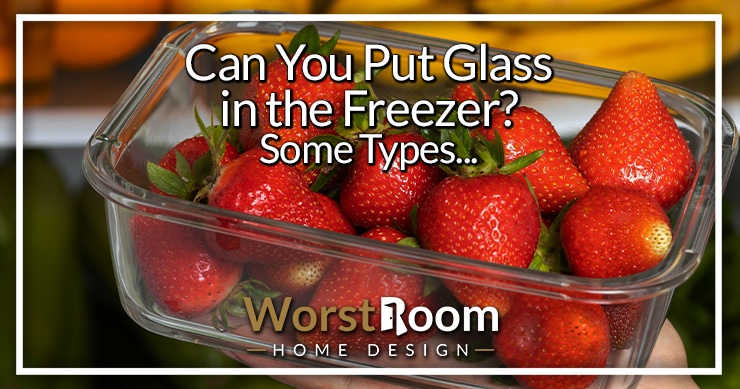
Many people find themselves asking: can you put glass in the freezer? After all, glass is readily available and easy to repurpose, especially in the kitchen. You use glasses for drinking beverages, jars for preserved goods from supermarkets, cookware lids, storage containers, and bowls.
However, to better understand the answer to the question "can you freeze glass", you’ll want to know the properties of glass. Not all glass is the same. When you understand the material, you’ll discover it can go in the freezer as long as you follow certain precautions. And, since all glass is different, it is wise to learn which types can freeze and which can’t.
Glass Types That Are Freezer Safe
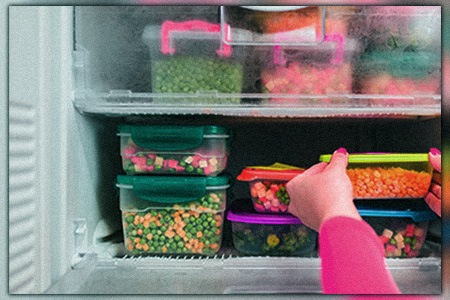
Most glassware in the kitchen is heat resistant up to a particular temperature (usually higher than the average home oven can get). Manufacturers advise that if the dish is safe to go in the oven, it is also safe for the freezer. Some freezer-safe glass dishes include canning jars, Pyrex brand storage containers, and most drinking glasses.
However, you must think about the type of dish before taking it from the freezer and putting it directly into a preheated oven or vice versa. Some glass won’t tolerate extreme temperature swings and can break from thermal shock.
What Is Thermal Shock?
Thermal shock occurs when glass does not tolerate extreme and sudden changes in temperature, causing it to break. Some types are more resilient to the temperature changes, such as CorningWare dishes. They can go directly from the freezer to the oven without issues.
How to Avoid Thermal Shock
If you aren’t sure what type of glass you have, it is good practice to take precautions to avoid thermal shock breakage. To do this, you should allow the glassware to come to room temperature slowly before and after freezing.
Don’t rush any thawing by forced heat treatment such as microwave or hot water bath. Likewise, don’t rush the cooling down process of hot leftovers by putting them in the fridge before the freezer. You can't put glass in the microwave anyways without breaking it.
How to Use Glass in the Freezer
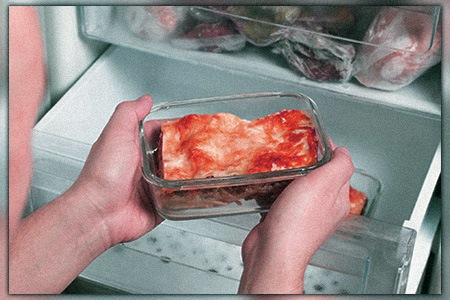
Can glass go in the freezer? Depending on what glass container you use to freeze your food, you’ll want to keep some helpful hints in mind. Because most food contains liquid, remember to compensate for expansion.
First and foremost, remember to slowly allow all food and containers to come to room temperature before and after freezing. That is the best way to prevent thermal shock. For example, don’t put glass from the freezer directly into the oven.
Canning jars are a bit tricky for storing food in the freezing. The majority of jars have a neck that narrows before the opening. Remember to leave space from the top to allow for expansion. It is ideal to leave about two inches of head space in a canning jar.
It’s advisable to avoid containers with odd shapes. Not only could this present issues with overflow during expansion, but it also causes space issues in the freezer. If it is all you have, keep in mind that head space.
Another helpful reminder is to store glass containers away from each other. Even a gentle clink of frozen glass can cause breakage. Placing a bag of veggies between containers is a good idea. And don't accidentally leave the freezer door open, either, by stacking too many things together horizontally. It happens more than you expect
For non-storing ideas, try placing a pint glass in the freezer before enjoying a cold beverage. The frosted mug is an impressive hosting feature and will keep your guests’ drinks cold. Remember to place it away from other glass containers in the freezer to prevent accidental breakage. So, does glass break in the freezer? It won't with basic care involved.
The History of Glass & Why Freezing is Questionable
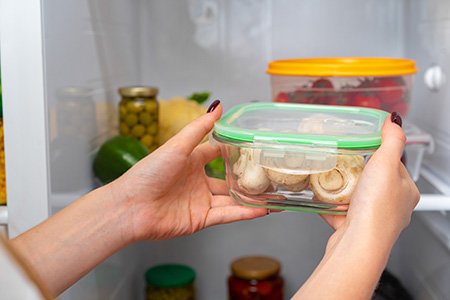
Thousands of years ago, Mesopotamians were thought to be the original glassmakers. Some people believe that the Phoenicians were the pioneers in the trade based on Pliny’s historical account of the sailors discovering that beach sand melted under their cooking fire and turned to glass upon cooling. The focus was then all on heat and not cooling.
Glassmaking has taken years to become an art. From shiny to matte, rough to smooth, no one knows what the early concoctions of glass were like. Experiments with different combinations of materials, particularly metallic oxides, led to colored glass. But even in recent history we didn’t have a way to freeze anything purposefully.
Some historians attribute changes in glassmaking to other tradespeople experimenting, such as a potter with his extremely hot kiln. Perhaps metalworkers experimented with glass in their forges. At one point, glass got sold in unshaped blocks. Glassmakers would buy the units of glass and shape them into beautiful and useful items to sell to the public.
Now glass manufacturers create all types of things, from bullet-proof car windows to shatterproof bottles. They have come so far as to design thin glass screen protectors for cell phones. Even after years of improvement throughout history, glass is still transforming to make consumers’ lives safer and more convenient.
What’s Used to Make Glass & Why it Matters for Freezing
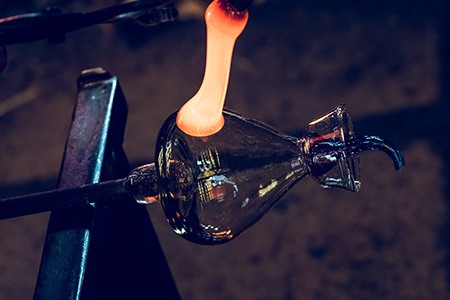
As you can see from the short history, glassmakers use readily available natural materials to make glass. Sometimes they use a mixture of materials, such as silica and sand, or pulverized quartz and alkali. Other materials, like metallic oxides, are added to create colorful glass products.
Some glass manufacturers use soda ash or limestone when creating their products. The ingredients depend on what the glassmaker wants to do with the material for their final product.
How Glass Is Made
Once you’ve gathered the materials, they’ll undergo an extreme heating process. A furnace is a tool that glassmakers use for the heating process. It should get up to roughly 1700 °C. That is where the materials will melt together and become more of a liquid or pliable material.
Once the materials melt into the glass, the glassmaker will take it out of the furnace and start to create the masterpiece. Some artists prefer to blow the glass into a shape, while others use their methods and tools when working with the glass. The cooling process can be different depending on the end product and the properties that it possesses.
6 Different Types of Glass
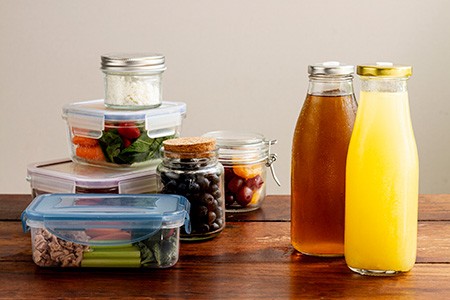
Can you put glass in the freezer? Well, there are many different kinds of glass. That is because glass has many different purposes. By adding other materials, or layering them with other materials, glass takes on other properties. If you can put glass in the freezer, let’s see what types are best in cold temperatures.
Safety Glass
The automobile industry uses safety glass in most of its vehicles. It is made to withstand the elements and comprises windshields and windows. You might hear this called tempered glass.
Computer Glass
It takes a unique type of glass for computer and cell phone screens. It must be delicate enough to allow the images to come through clearly. It is thin and must be flat so that the images don’t warp.
Ceramic Glass
Almost every kitchen has an item made from ceramic glass. That is typically a pottery item with a glass coating around it as a sealant and protectant from heat. It is oven-safe because of the glass on the outside. It does not break because of thermal shock. CorningWare is probably the most popular manufacturer of ceramic glass dishes.
Plate Glass
This type of glass is in windows and glass door construction. It is strong but a bit flexible to withstand high winds. It is a mixture of soda-lime silicate glass. Will glass break in the freezer? If you could fit these in your freezer, you'd find they won't just like they don't when the temperature reaches below freezing outside.
Art Glass
Otherwise known as leaded crystal, art glass is a luxury item. Crafted as individually unique products, crystal glass is both ornamental and functional in the home.
Mirror Glass
Dating back to 1835, mirror glass has been used in homes all over. It is silver-coated glass. Hot aluminum or other silver material bonds to the surface of the glass through a special process.
Among these different types of glass, you’ll find heat-resistant products in the kitchen. Pyrex is an example of a manufacturer that produces casserole dishes or storage containers made from heat-resistant glass. To be precise, Pyrex is borosilicate glass and is resistant to drastic temperature changes.
So, Can You Put Glass in the Freezer? Depends!
Yes, you can put most glass in your kitchen in the freezer. Most glassware is tempered glass that has a high resistance to thermal shock. Just remember to take precautions and allow the glass and food to come to room temperature slowly before and after freezing. Just remember, can you put glass in the freezer? Yes, most of the time.




